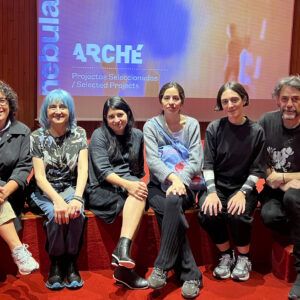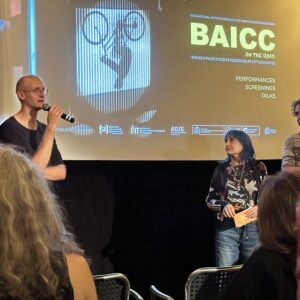
How did your interest in structural cinema begin?
Studying third of Fine Arts at the University of Barcelona, during 1999, when Eugeni Bonet taught a subject called Theory and history of experimental cinema. Also watching films from the Shoot, Shoot, Shoot program -commissioned by Mark Webber- about the London Film-Makers’ Co-operative, which was shown at Fundació Tàpies in November 2002 and from the reading of the ‘Structural Film’ chapter of the book Visionary Film by P. Adams Sitney. I got a copy in 2003.
The sound in structural cinema is a subject that has constituted a long-term interest in your work as a researcher, which leads to the publication of the book Resonancias fílmicas. Can you tell us about this investigation and its findings?
Resonancias fílmicas. El sonido en el cine estructural (1960-1981) is a book by the Shangrila publishing house that was published in May 2017. It is the reformulation of an academic research, a doctoral thesis developed over five years in a doctoral program on theory of cinema at the Pompeu Fabra University. The main objective of the work was to analyze the different processes of sound exploration of a set of films shot in16 mm by a group of filmmakers more or less linked to structural cinema. The notion of noise, the treatment of the voice, the incorporation of the soundscape and the idea of silence were some of the parameters that structured a paper that tried to expand the geographic and temporal framework under which this film, also designated as structural-materialist, systematic, minimalist or conceptual cinema. One of the findings of the book is the fact of emphasizing the sonic mechanisms used by the filmmakers themselves and the acoustic consequences that these resources have during the screening of their films for the audience.
When you began to conceive the selection of Patterns of Interference, what aspects did you think it would be basic to include in relation to structural sound?
Including current titles made in both digital video and 16mm was one of the premises to consider. Also the fact of adding pieces created by filmmakers here, such as Blanca Rego, Pablo Useros, Jorge Cosmen and Alberto Cabrera Bernal. I considered that programming the titles of the new millennium allowed observing how certain considerations of the primordial structural cinema are still present today. Concerning sound level, the ten films of the program denote literal synchronicities between image and 16mm sound, suggest intermittent musicality by means of appropriation montages, evoke digitally created noisy formulations or signal the value of the sonorous manifested through murmurs or performatic gestures. Discarding all the films introduced in the publication was another initial consideration. Finally, there are only two films of the seventies -by Barry Spinello and Ryszard Wasko- that use the resource of repetition to articulate auditory variations.
If you had to quote three basic pioneers in relation to the use of sound in structural cinema, who would they be and why?
Michael Snow, Paul Sharits and Lis Rhodes. Snow because he developed an amazing film corpus about sound in titles such as the mythical Wavelength (1967) or the monumental ‘Rameu’s Nephew’ by Diderot (Tanx to Dennis Young) by Wilma Schoen (1974). Sharits because he theorized about the relevance of sound in film writing articles like ‘Hearing: Seeing’ (1978) and creating moving soundtracks like S: TREAM: S: S: ECTION: S: ECTION: S: S: ECTIONED (1971). Rhodes because he delved into the optical options of 16mm film sound with films inspired by abstract animation or focused on the expanded film installation. His film Notes From Light Music (1976) is, without a doubt, one of the definitive films assigned to what is known as ‘optical film sounds’, sounds generated by the optical soundtrack – activated by the photoelectric cell of the 16mm projectors- that generate unheard of sounds.





